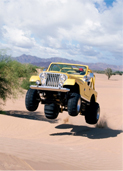
Desert damage
OHV use in fragile desert ecosystems destroys soil crusts and soil stabilizers, increases wind and water erosion, contributes to soil compaction, and decreases water infiltration into the soil.
OHV Recreation
OHV use is a popular recreational activity in the California desert. OHVs, also known as ORVs (off-road vehicles), include four-wheel drive trucks and sport-utility vehicles, all-terrain vehicles (ATVs), and dirt bikes. The creation of new, illegal OHV routes is a serious problem on BLM land. A single pass by a vehicle will leave a track, and repeated use of the track can create a visible trail.1 The inadvertent or intentional creation of new trail networks in desert areas is particularly problematic because the lack of dense vegetation makes it easy for OHVs to drive off-route. Equally challenging for the BLM are closing illegal routes, restoring past damage, and preventing the creation of illegal routes in the first place. OHV use in fragile desert ecosystems destroys soil crusts and soil stabilizers, increases wind and water erosion, contributes to soil compaction, decreases water infiltration into the soil, crushes plant stems, foliage, and roots, and increases noise and air pollution that negatively impacts wildlife.2 OHV use in the Mojave Desert has been shown to produce noise levels loud enough to cause hearing loss in kangaroo rats (Dipodomys spp.) and fringe-toed lizards (Uma spp.), which may affect species survival.3 OHV use in legal recreation areas can also have negative ecological effects. For example, the Imperial Sand Dunes Recreation Area is an intensively used OHV area that receives over 1.4 million OHV visitors per year.4 OHV use has been found to negatively affect the survival of an Algodones Dunes endemic plant, the Peirson’s milk-vetch (Astragalus magdalenae var. peirsonii), a threatened species under the Endangered Species Act, causing both short- and long-term damage.5
1 M.L. Brooks and B.M. Lair, “Ecological Effects of Vehicular Routes,” In The Mojave Desert: Ecosystem Processes and Sustainability, ed. R.H. Webb, L.F. Fenstermaker, J.S. Heaton, D.L. Hughson, E.V. McDonald, and D.M. Miller, (Reno: The University of Nevada Press, 2009), 168-195.
2 J.E. Lovich and D. Bainbridge, “Anthropogenic Degradation of the Southern California Desert Ecosystem and Prospects for Natural Recovery and Restoration,” Environmental Management 24, no. 3 (1999): 309-326.
3 B.H. Brattstrom and M.C. Bondello, “Effects of off-road vehicle noise on desert vertebrates,” in Environmental effects of off- road vehicles: impacts and management in arid regions, ed. R.H. Webb and H.G. Wildshire, (New York: Springer-Verlag, 1983), 167-206.
4 Bureau of Land Management, Imperial Sand Dunes Recreation Area Management Plan (RAMP), 2003, El Centro Field Office, http://www.blm.gov/ca/st/en/fo/elcentro/recreation/ohvs/isdra/dunesinfo/....
5 J.D. Groom, L.B. McKinney, L.C. Ball, and C.S. Winchell, “Quantifying off-highway vehicle impacts on density and survival of a threatened dune-endemic plant,” Biological Conservation 135 (2007): 119-134.
